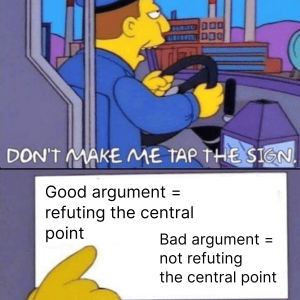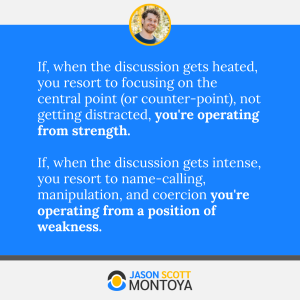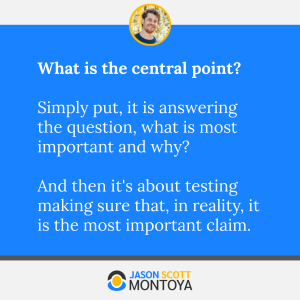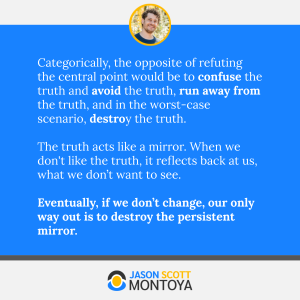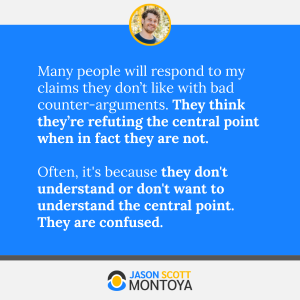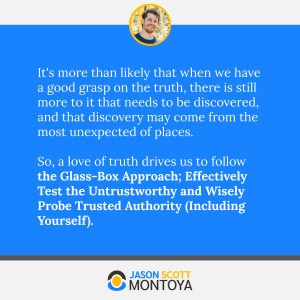
Rid Yourself of Intellectual Weakness & Start Conversing From A Position of True Strength
DON'T MAKE ME TAP THE SIGN.
- Good argument = refuting the central point
- Bad argument = not refuting the central point
If, when the discussion gets heated, you resort to focusing on the central point (or counter-point), not getting distracted, you're operating from strength.
If, when the discussion gets intense, you resort to name-calling, manipulation, and coercion you're operating from a position of weakness.
So, what is the central point? Simply put, it is answering the question, what is most important and why? And then it's about testing making sure that, in reality, it is the most important claim.
In this post, I want to share a framework to help you see when you're operating from a weak foundation so that you can become a strong leader who stays focused on what matters most. As leaders grow and gain more authority and influence, the distractions will become more intense, so to be a great leader is to understand how to communicate and how to effectively and wisely navigate controversial topics.
This type of strength is not easy, requires practice, and it takes a commitment.
How to Disagree: Paul Graham's Hierarchy of Disagreement
If the main focus is the central argument, an effective way to respond to propaganda, what are the stages that can help us know when we're getting distracted? The pyramid visual below helps us see more clearly.
Paul Graham’s hierarchy of disagreement gives us a spectrum of how close (or far away) we are to what matters. It's a simple and helpful way to visualize this idea of the central point and the competing distractions.

- Refuting the Central Point > explicitly refutes the central point
- Refutation > finds the mistake and explains why it's mistaken using quotes
- Counterargument > contradicts and then backs it up with reasoning and/or supporting evidence
- Contradiction > states the opposing case with little or no supporting evidence
- Responding to Tone > criticizes the tone of the writing without addressing the substance of the argument
- Ad Hominem > attacks the characteristics or authority of the writer without addressing the substance of the argument
- Name-Calling > sounds something like, “You are an ass hat.”
Graham identifies the lowest forms of argument as name-calling and ad hominem (personal) attacks. If you are operating at the bottom of the pyramid on your Facebook wall, text messages, or in-person discussions, you've resorted to the weakest form of discussion. This is a sign you are in over your head and need to take a step back to figure out why.
Categorically, the opposite of refuting the central point would be to confuse the truth and avoid the truth, run away from the truth, and in the worst-case scenario, destroy the truth. The truth acts like a mirror. When we don't like the truth, it reflects on us, what we don’t want to see. Eventually, if we don’t change, our only way out is to destroy the persistent mirror.
The highest form of disagreement is explicitly making a central claim or refuting that central point in a counter-argument. There is always the temptation to operate lower in the pyramid, but for those who want to make a positive difference in a sea of chaos, moving to the top of the pyramid is key. Only the strong in character and wisdom can move towards and stay at the top of the pyramid. If you find yourself regularly living at the bottom, you've got weaknesses to work on.
A Political Example Of Focusing On the Central Issue
One of the reasons I didn’t vote for Trump in 2016 was because of his wake of brokenness and exploitation of others before he ran for president.
One of his well-known train wrecks is the Trump University fraud. Tristan Snell was involved in the Trump University lawsuit against Donald Trump, which involved Trump financially exploiting over 6,000 victims.
Snell talks about this idea of focusing on the central idea and how Trump has mastered the art of the lower rungs of the hierarchy (which is what makes him weak). Trump is famous for name-calling and he lives at the bottom of the pyramid. He knows how to create distractions and draw people away from the central point.
Snell gives us a glimpse into how to navigate this dynamic; again, focusing on what matters most when the other is focused on maximizing distractions.
"You really have to focus on the signal, not the noise. Trump is going to wheel in the the clown car of attorneys and he's going to make all sorts of outlandish arguments. He's also going to do a lot of counter attacking.
There's a different rule that you have to be stoic and stay the course and focus on your case. There is a Temptation in situation like that to go swinging at every ball that they throw at you and a lot of those balls are going to be in the dirt and you can't swing at them. You need to basically focus on what's your case in Chief. What law are you trying to apply? What evidence do you have? Stay focused on that." - Tristan Snell, Trump's New York Civil Fraud Trial on Lawfare
This insight is our reminder to keep the target, our end game, in mind. Stay focused and clear on what matters most. Don’t stray from this vision.
Getting distracted is often driven by our desire to alleviate the tension created by staying focused on the primary priority. Other times, our vulnerability to distraction is a lack of clarity of vision.
If you'd like to explore an example of me navigating the noise and focusing on the central point, check out my article about Joe Biden winning the 2020 election. Few other examples had as many distractions and deceptions as America's 2020 presidential election outcome. It's a great case study on finding and focusing on the central issue and seeing how effectively it fends off all the distractions.
Audience: Who Are You Talking To?
Former atheist Christopher Hitchens was a master of focusing on and persuading his audience in the many debates he's conducted with Christians. I always found his discussions compelling, even if I disagreed with his conclusions. He was persuasive and his example is instructive.
It’s vital to keep our primary target audience in mind. In a court case, it’s going to be the jury and judge. If we’re doing a public debate, it’s the watching audience. If we’re attempting to persuade people, it may be the more persuadable and not the entrenched folks who are loudest or want to troll us. Losing sight of our core audience and core issues is one of the many ways we get distracted.
Ask yourself, to whom are you speaking, what do you want them to take away? And, ideally, how would you like them to respond to what you're sharing?
Ironically, by focusing on the core issue and the core audience, we’re more likely to impact those inside and outside of the target audience too, so there is an extended benefit.
Getting to the Truth: Relevance & Navigating the Lies
When we have clarity on the central point, it's on the refuter to demonstrate why their counter-argument is relevant to the central claim, if it's not obvious.
Many people will respond to my claims, that they don't like, with bad counter-arguments. They think they're refuting the central point when in fact they are not. Often, it's because they don't understand or don't want to understand the central point. They are confused.
When they connect the dots of how their counter-argument is connected to the central point, they will see the problem in their argument. In these cases, if the person is engaging in good-faith conversation, it can be worth clarifying the central point and asking the refuter to demonstrate why their point is relevant to the main claim.
When someone can’t refute the central arguments, they are often sliding down to the bottom of the pyramid. It's probably a sign that their argument is more ideological or socially based, and not based on what is true. Or, they don't know how to make the argument.
Ultimately, what helps us withstand propaganda, is a love and pursuit of truth, even when we don’t like what it indicates or when it’s at odds with what we want. Most people don't want the truth, they just want to hear what affirms what they already believe to be true, and they resist that which disrupts it.
It's more than likely that when we have a good grasp on the truth, there is still more to it that needs to be discovered, and that discovery may come from the most unexpected of places. So, a love of truth drives us to follow the Glass-Box Approach; Effectively Test the Untrustworthy and Wisely Probe Trusted Authority (Including Yourself).
Social Media Sharing Graphics
- Created on .
- Last updated on .
